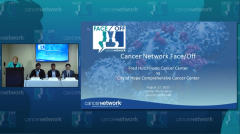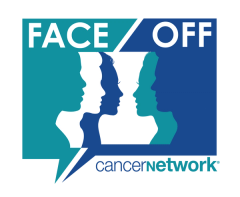
Cross Q&A: Evaluating Ponatinib and Asciminib as 3L Therapy in CML
Considerations for selecting between ponatinib and asciminib as third-line therapies for CML based on factors such as disease burden, mutations, and patient tolerability.
Episodes in this series

Transcript:
Judy Schreiber, PhD, RN: If we want to have the response from Dr Koller to you on this particular presentation?
Paul B. Koller, MD: I think you asked the questions in your last slide that I was going to ask you. And I think that we’re all…interested in the field. So…bosutinib is not a very good comparator for this. Frankly…I’m surprised that they were able to get away with it. What are your thoughts, now that we have asciminib and ponatinib available in the third line that are potent…how do you pick one versus the other? I’d love to hear what you think.
Vivian G. Oehler, MD: I think that’s the million-dollar question, Dr Koller. I agree with you…I really think the question comes down to, olverembatinib is going to be another third-generation TKI, so how are we going to use these drugs? I will walk you through how I think about this. For me, I think about this in terms of, well, let’s say everyone’s intolerant, but what’s your BCR-ABL burden of disease? So, at the top there, if you had an arrow going downward, it would be red going toward green, and the answers are already there.
So for somebody on third-line therapy who has a high BCR-ABL greater than 10% and no mutations, those patients are extremely worrisome to me. Based on the data that I’ve found buried in supplemental and real-world data, I favor ponatinib in that population. We can say the AOE [arterial occlusive event] rate might be a little bit higher, [to be determined] with the new changes, but being off-target is [almost] better than being on-target because there [are] data from Dr Druker’s lab that some of these things like fibroblast growth factor receptor…are actually relevant in CML [chronic myeloid leukemia] disease progression. So maybe having a less clean drug in some of these patients, and not just potency, is the issue.
This is me. I actually put my name, my thoughts, on this slide. So this is not the right answer, this might be just the way I think about it. If I have a T315I mutation with a high burden of disease, well, if I use the right dose, maybe I’ll get away with either. I might favor ponatinib, again, following my reasoning that a high burden of disease for longer term might be a little bit scarier in terms of unexpected disease progression. But as I go down to deeper responses, I favor asciminib more and more in my patients because of the better tolerability. And with a lot of anecdotal data, using my own practice, I have a lot of asciminib-treated patients. It really is well-tolerated.
And so…I don’t like to necessarily jump [from] second generation to second generation, unless I have a patient who’s got a really good response, and then I won’t. But don’t forget transplant. We can talk about sequencing drug to drug to drug, but ultimately there’s going to be a group of patients, and this happened to me [during the COVID-19 pandemic], where a patient was lost to follow-up and the next thing you know, they present with disease progression and suddenly you need transplant, and overall survival is only 40% at 3 years. So, of course, there are other considerations. If you’re young and fit, I’m not so worried. But if you have comorbidities and cardiovascular comorbidities—Dr Kohler, as you talked about before—you have to balance these things. It’s saving your life versus the risk for the other. So, that is…how I think about these things a little bit in a nutshell. How do you [think about it], Dr Kohler?
Paul B. Koller, MD: This is great. I think this summarizes…how I’ve thought of this. I’m going to actually ask you for this [slide].
Vivian G. Oehler, MD: We have the better version. It’s got like cool arrows on it, and it even puts olverembatinib into this.
Paul B. Koller, MD: But…at least anecdotally, [with] the people that I’ve talked to—and, just a disclosure, Dr Oehler and I have talked about many things…outside of this, and we have never had this discussion before, so it’s interesting that we’ve come to the same place—it’s the same way. I see ponatinib as maybe more active than asciminib. I think because bosutinib is such a poor comparator, and the patients on…the landmark study were not as refractory; [there was] more intolerance.
And then I think there’s…the dosing. I’ve seen this a lot in my practice where the asciminib dose escalation can resalvage people [who] have failed lower doses. And so…[with] more disease, I would favor ponatinib. I think with a T315I [mutation], I generally favor ponatinib because a lot of the data on tolerability [are] in this…40 [mg twice daily], but I think we use 80 mg a day. And then we both have, and she can say the name better than me, but I’m going to call it HQP1351 [olverembatinib]. I always leave out a syllable. But we both have that available at our institutions, and it is a nice compound for us.
Transcript is AI-generated and edited for clarity and readability.
Newsletter
Stay up to date on recent advances in the multidisciplinary approach to cancer.




















































































